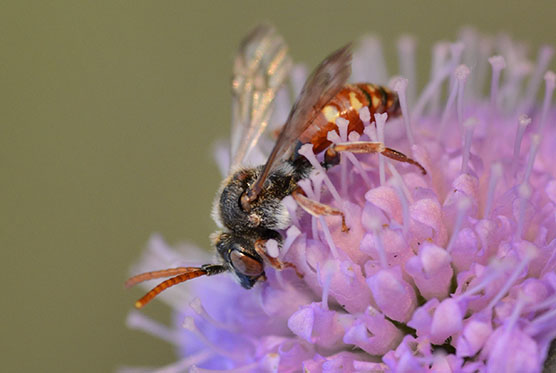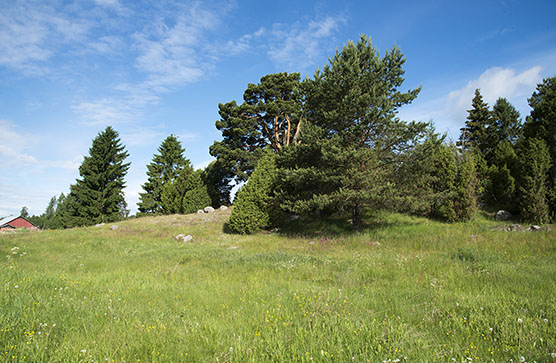Press release 2019-08-21 at 8:00
Finnish Environment Institute and the Finnish Expert Group on Hymenoptera news 21 August, 2019
Species in our country's largest order of insects are increasingly under threat. In an assessment of threatened species made public in the spring, about 16 % of our species of Hymenoptera were assessed as endangered. The best-known subclade are the Aculeata, in which 15 percent of species that were assessed were listed as threatened. Overgrowth affecting meadows as well as sunny and dry habitats such as sand banks is the most significant threat to Aculeata. Many Hymenoptera species are also threatened by construction, the decrease in dead trees, and changes in agriculture.

Nomada armata is a rare bee classified as vulnerable (VU), now found only in Eastern Finland. The species lives in sunny grasslands and on roadsides, and the species is threatened primarily by the overgrowth of open areas and construction. Photo: Juho Paukkunen.
In the threat assessment for 2019 nearly one fifth of the 1,394 Hymenoptera species living in Finland were assessed. The assessment was not as inclusive as in the previous study from 2010. The most detailed examination involved the threat level facing the Aculeata (more than 95% of 673 species were assessed). Fewer than half of the species of Symphyta and Parasitica, about 750, were assessed.
Overgrowth of open habitats harms the lives of Aculeata
Of the species of Aculeata in Finland, 97 are threatened and 76 are near threatened. The numbers remained unchanged from the previous assessment. However, the number of species considered to have become regionally extinct in Finland had increased by four from 2010. The main reason for the decline in threatened Hymenoptera is the overgrowth of meadows, grasslands, and sunny and dry habitats, which causes the abundance of species of food plants to wane, weakening the viability of Aculeata.
The pollinators of flowers and many useful plants suffer the worst. With Apoidea, which are important pollinators, the proportion of threatened species, 17%, is clearly higher than average. In addition, the proportion of species that have become regionally extinct, 5%, is many times that of the average for all taxa.
The decline in the amount of dead wood material is the primary cause of the decline among 19 threatened and 15 near threatened Aculeata. The increasing threat to hole nesters stems from the decrease in decaying wood and wood structures (log buildings, barns, wooden fences).
Intensive farming has reduced the numbers of Aculeata that nest on the shoulders of roads and the sides of ditches. The construction of roads may also destroy nesting places of Hymenoptera. Although some of our threatened Aculeata live in protected areas, they cannot survive without more extensive care of grasslands and meadows. The problems facing ground nesters are eased somewhat by alternate habitats such as airports, rail yards, and landfills. Climate change especially threatens bumblebees living at high elevations in the north of Finland.
Symphyta also suffer from the closing of open environments
Compared with previous evaluations, the number of species of Symphyta classified as threatened has continued to rise from the previous 42 species to 47, and the number of near threatened species has also increased. However, there is also cause for optimism, as three species of Symphyta, which had been classified as regionally extinct, have been found again in Finland. However, all these species are still considered to be threatened. Most of the species of Symphyta classified as threatened live in deciduous woodlands, heath forests, or on grasslands and damp meadows. The overgrowth of open meadows and forest management measures as well as the proliferation of spruce trees in groves are the main reasons for the threatened status.

Active grazing is used to care for a thriving meadow in Hyvinkää. Many species of Hymenoptera live there, including the short-haired bumblebee (Bombus subterraneus), which disappeared from Britain in 2000. Photo Riku Lumiaro.
Parasitica – life impossible without a host
Parasitica are the insect group with the largest number of species. Of the evaluated species of Parasitica, 82 were classified as threatened, 79 as near threatened, and 11 as regionally extinct. The proportion of threatened species among those that were assessed was significantly high - 21%.
The decline of the Parasitica, which develop as parasites of other insects and arachnids, is usually the result of a decline in host animals, and the situation is especially problematic with hyperparasites. Parasitica are a group that is not yet very well known, but the research community, along with experts from abroad, have produced much new information about Parasitica species in Finland, and this has even led to the discovery of species in our country that are new to science.
Further information
Senior Museum Technician Juho Paukkunen, Finnish museum of natural history, tel. +358 50 318 2349, firstname.lastname@helsinki.fi
Environmental Specialist Reima Leinonen, Kainuu ELY Centre, tel. +358 40 529 6896, firstname.lastname@ely-keskus.fi
Docent Ilkka Teräs, tel. +358 50 563 8845, firstname.lastname@helsinki.fi
Further information on threat assessment